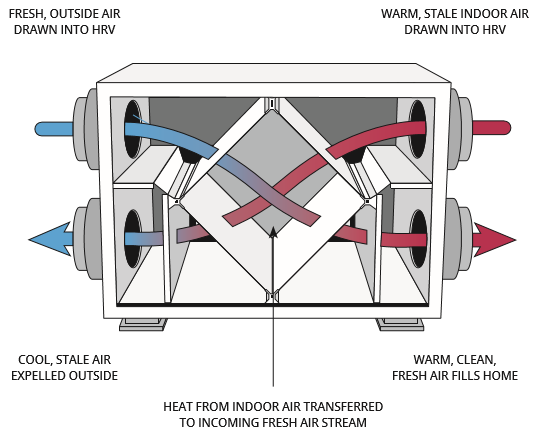How to Save Money with HRV in Warm Climates
Wiki Article
Just How Heat Recovery Ventilation Improves Indoor Air Quality and Reduces Power Prices
Heat Recovery Ventilation (HRV) systems play an important function in boosting indoor air top quality while at the same time decreasing power costs. By successfully exchanging stale interior air with fresh exterior air, HRVs help keep optimal humidity and reduce pollutants. Additionally, their capability to recuperate heat from outbound air minimizes the pressure on home heating and cooling down systems. As energy prices remain to increase, understanding the complete capacity of HRV systems ends up being increasingly vital for home owners and organizations alike.Understanding Heat Recovery Ventilation Equipments

Heat recovery ventilation (HRV) systems play a necessary duty in boosting indoor air quality, especially in contemporary, energy-efficient structures. These systems are designed to move warm from the outward bound stale air to the incoming fresh air, thus minimizing power loss while keeping ideal temperature levels inside your home. HRVs contain a warmth exchanger, followers, and ductwork, helping with the continual circulation of air. By removing indoor pollutants and presenting fresh air, HRVs aid to balance humidity levels, avoid mold and mildew growth, and decrease irritants. The effectiveness of HRV systems depends on their capacity to recover up to 80% of the heat from the tired air, advertising energy conservation while guaranteeing a healthy and balanced interior atmosphere. Their assimilation is important in accomplishing sustainable living practices.
The Importance of Indoor Air Quality
Indoor air quality (IAQ) is a critical aspect influencing the health and wellness and health of owners in any setting. Poor IAQ can bring about various health problems, including breathing problems, allergic reactions, and exhaustion. Furthermore, it can worsen current conditions such as asthma. Factors adding to reduced IAQ consist of toxins from interior resources like cleaning up agents, mold and mildew, and poor air flow. Maintaining good IAQ is important for advertising a risk-free and comfy living or working room. Efficient strategies to enhance IAQ involve routine monitoring of air high quality, proper ventilation systems, and minimizing making use of dangerous substances inside your home. By prioritizing IAQ, individuals can assure a healthier atmosphere that cultivates efficiency and total quality of life.Power Efficiency Advantages of HRV Systems
Several property owners and structure managers are progressively recognizing the energy performance benefits of warm recovery ventilation (HRV) systems. By moving heat from tired interior air to inbound fresh air, HRV systems noticeably minimize the energy needed for cooling and heating. This procedure decreases reliance on standard HVAC systems, causing lower power bills. In addition, HRVs help preserve a balanced interior environment, protecting against extreme heating or cooling down needs. The capability to recuperate approximately 90% of the warm from outgoing air likewise sustains sustainability efforts by lowering general energy usage. Subsequently, HRV systems contribute not just to set you back financial savings yet likewise to a decreased carbon footprint, straightening with the expanding emphasis on energy-efficient structure methods.Setup and Maintenance Considerations
The effective application of heat recuperation ventilation (HRV) systems calls for cautious consideration of setup and maintenance elements to guarantee peak efficiency. Proper positioning of the HRV unit is crucial, as it needs to be installed in an area that maximizes airflow while lessening noise disruption. Furthermore, ductwork must be suitably sized and insulated to avoid energy loss. Routine upkeep, including filter replacement and system cleaning, is important to secure ideal functionality and indoor air top quality. Owners need to establish a routine upkeep schedule to identify and attend to possible issues prior to they rise. Collaboration with skilled specialists throughout both setup and maintenance stages can boost the longevity and efficiency of HRV systems, eventually bring about better indoor his response atmospheres and minimized power prices.
Real-World Applications and Success Stories
Exploring real-world applications of heat healing air flow (HRV) systems exposes their considerable influence on interior air top quality and power efficiency across various Click Here settings. In property structures, house owners have actually reported better air top quality, resulting in less allergic reactions and respiratory system concerns. Schools executing HRV systems have actually kept in mind improved trainee focus and reduced absenteeism as a result of better ventilation. Industrial structures, such as offices and retail rooms, have actually experienced lower energy prices and enhanced worker performance. A corporate workplace in a temperate climate accomplished a 30% decrease in power costs after installing an HRV system. These success stories demonstrate that HRV innovation not only adds to much healthier settings yet also provides tangible monetary benefits, making it a useful financial investment for numerous fields.Regularly Asked Questions
Can HRV Equipments Decrease Allergens in Indoor Air?
The performance of HRV systems in minimizing interior irritants largely rests on their capability to filter and exchange air. HRV Heat Recovery Ventilation. By constantly changing stale air, these systems can significantly lower allergen levels throughout interior environments
Just How Does Humidity Affect HRV System Efficiency?
Moisture significantly affects HRV system efficiency; high degrees can result in condensation, reducing performance, while reduced moisture may enhance air exchange. Balancing moisture is vital for perfect procedure and preserving interior air high quality.Are HRV Systems Noisy During Procedure?
HRV systems can produce varying sound degrees during operation, relying on their design and setup. Some systems operate quietly, while others may you can try these out create recognizable sound, specifically at greater airflow settings or when badly preserved.What Is the Average Life-span of an HRV System?

Can HRV Equipments Be Utilized in All Climates?
HRV systems can be used in various environments, but their efficiency might vary - HRV Heat Recovery Ventilation. In severe temperatures, changes or additional systems may be required to assure optimal efficiency and comfort while preserving interior air high qualityReport this wiki page